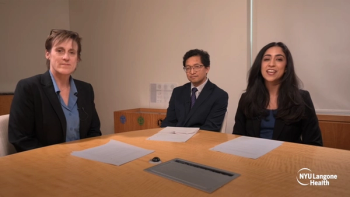
OCT development, implications for the anterior segment surgeon focus of Innovators Lecture
Washington, DC — Carmen A. Puliafito, MD, was chosen to present the Charles D. Kelman Innovator's Lecture at the 2005 ASCRS Symposium on Cataract, IOL, and Refractive Surgery in recognition of his work as the co-inventor of optical coherence tomography (OCT).
April 19 - Washington, DC - Carmen A. Puliafito, MD, was chosen to present the Charles D. Kelman Innovator's Lecture at the 2005 ASCRS Symposium on Cataract, IOL, and Refractive Surgery in recognition of his work as the co-inventor of optical coherence tomography (OCT).
Dr. Puliafito told attendees that the story of the development, evolution, and future of OCT will reflect two main themes: individuals can make a difference and technology is the unstoppable force that drives society and medicine.
"Nothing in life or in medicine is inevitable-we can all make a difference, and it is up to us to use technology in a way that will benefit our patients and the rest of humanity," stated Dr. Puliafito.
He described OCT as the first optoelectronic eye imaging system and noted it has been one of the most rapidly adopted ophthalmic technologies in history. In 1995, Dr. Puliafito remained the sole owner of an OCT device, and there was little change in that situation over the next few years. Currently, however, almost 4,000 OCT instruments are in use.
"OCT has clearly become ubiquitous technology. In 1994, I envisioned OCT as something that would be a specialized test for the retinal specialist, but I was wrong. It has emerged as a broad-based test and at the Bascom Palmer Eye Institute it has outstripped fluorescein angiography as the most commonly performed diagnostic study," he said.
Dr. Puliafito illustrated the utility of OCT in assessing retinal disease and for providing greater understanding of pathology and correlations between structure and function. He noted retinal imaging with OCT is valuable for cataract surgeons in assessing the presence of pre-existing macular disease that would limit visual function after cataract surgery and for evaluating cystoid macular edema postoperatively.
"In my experience, preexisting retinal disease is one the most common reasons for patient unhappiness after cataract surgery while cystoid macular edema is a common cause for a poor visual outcome after cataract surgery," he said.
Anterior segment OCT was recently introduced, and it allows evaluation of abnormalities in the anterior chamber, angle and cornea while representing the best tool for high resolution biometry of the anterior segment.
"OCT will be invaluable in making accurate preoperative and postoperative assessments in phakic IOL patients," Dr. Puliafito said.
In addition to growth in the use of anterior chamber imaging, OCT will continue to get better in the future with the development of higher resolution, higher definition devices able to perform faster scans with larger data sets and more elegant, clinically useful analysis algorithms. Reconstruction of a fundus image from the OCT dataset and precise placement and recall of OCT sections are also advances expected in the future.
Newsletter
Don’t miss out—get Ophthalmology Times updates on the latest clinical advancements and expert interviews, straight to your inbox.













































